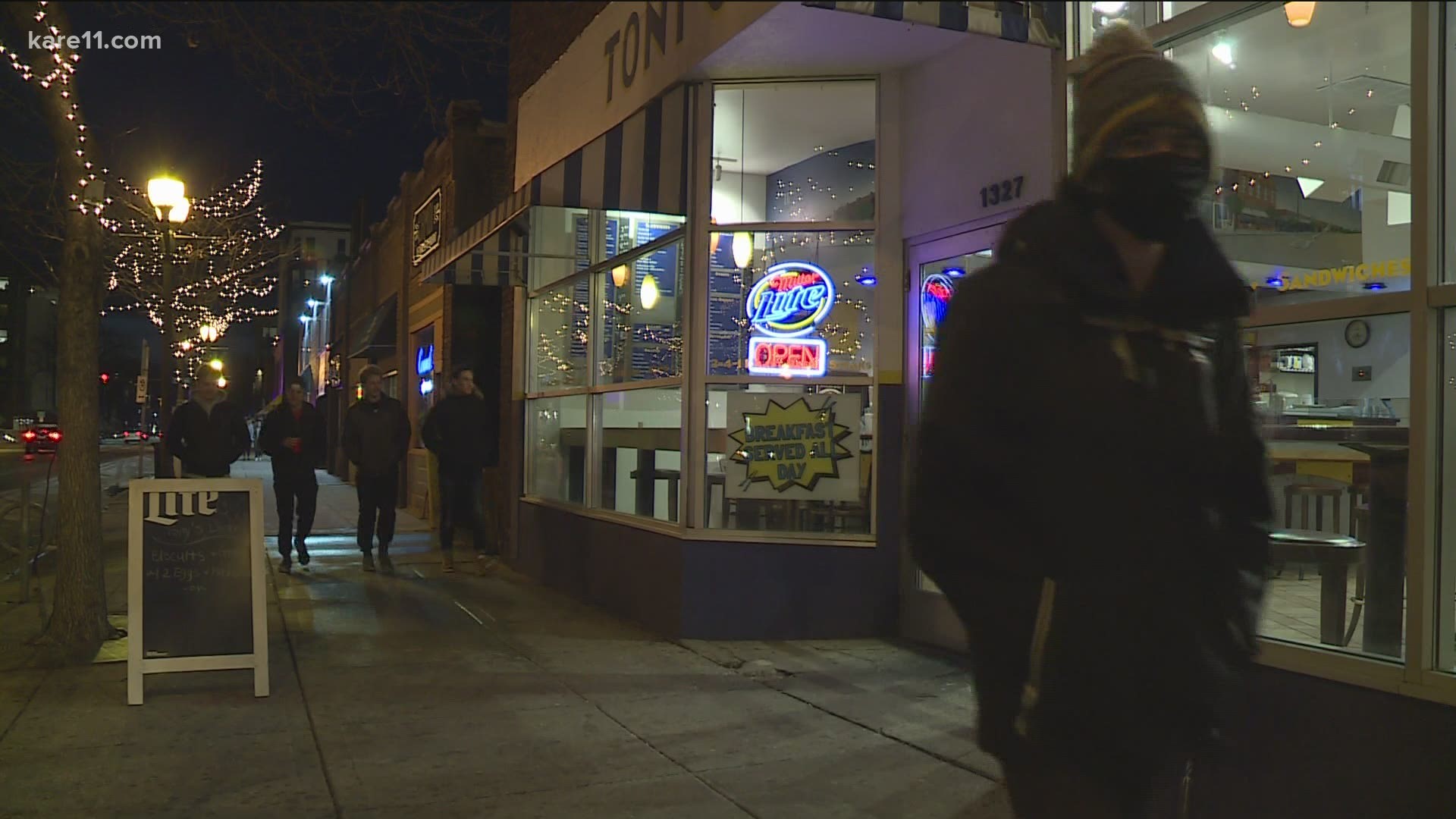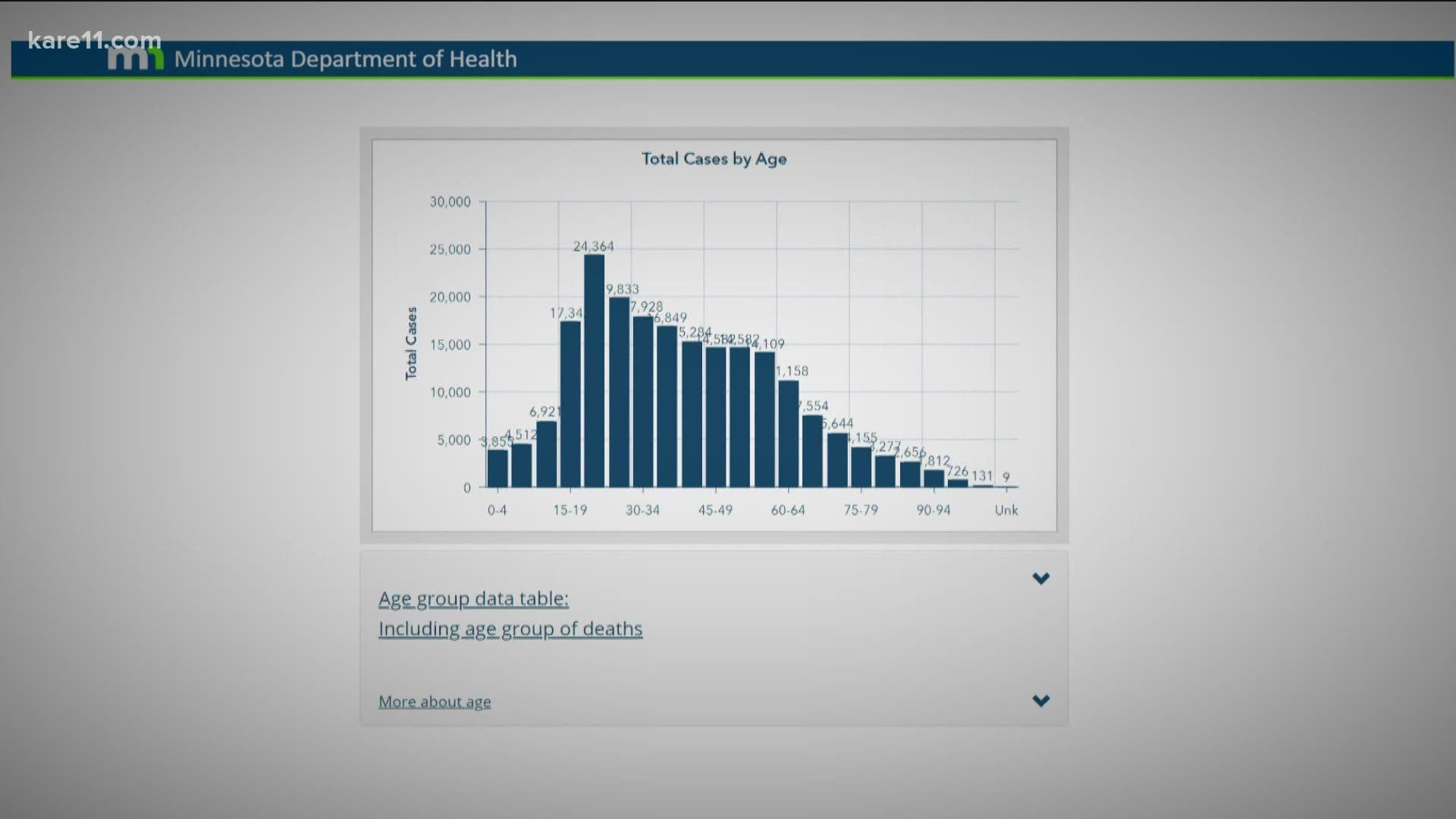ST PAUL, Minn. — Sunday, Nov. 15
2 p.m.
The Wisconsin's Department of Health Services (WDHS) reported 6,058 new cases on Sunday, bringing the total number of confirmed cases statewide to 312,369.
Health officials reported 12 more deaths Sunday as the total number of fatalities statewide climbs to 2,637. The total number of fatalities is approximately 0.8% of those testing positive for the virus.
Due to high case numbers, Gov. Tony Evers issued an emergency order mandating indoor face coverings that began at 12:01 a.m. Saturday, Aug. 1. On Tuesday, Sept. 22, Evers extended the mask mandate until Nov. 21.
On Tuesday, Oct. 6 Gov. Evers' administration issued a new order limiting the size of public indoor gatherings to 25% of capacity, to stem the spread of COVID-19. That order was struck down on Oct. 13 by a judge in Sawyer County. The order was reinstated on Oct. 19 by a Barron County judge, but on Oct. 23, a Wisconsin appeals court put a hold on the order.
Wisconsin health officials say a total of 14,381 people have been hospitalized from the coronavirus since the start of the pandemic, about 4.6% of the total number of people who have been diagnosed with the virus.
Of the confirmed cases in Wisconsin, 21% involve people between the ages of 20 to 29, 16% are between 30 and 39, 15% are between 50 and 59, and 14% are 40 to 49. An estimated 11% are between 10 and 19, and another 11% are between 60 and 69.
As of Sunday, Milwaukee County reported the largest number of confirmed cases with 55,918, along with 643 deaths. Dane County has reported 21,720 confirmed cases and 61 deaths, and Brown County has 19,843 cases and 121 deaths.
A more detailed breakdown of cases by county can be found on the DHS website.
11 a.m.
The Minnesota Department of Health (MDH) reported 7,559 new COVID-19 cases Sunday, along with 31 new deaths.
MDH's COVID-19 case definition was recently updated to include antigen testing. Previously, cases were only reported through polymerase chain reaction (PCR) testing. Positive PCR test results are considered confirmed cases, while positive antigen test results are considered probable cases.
MDH will combine these totals for its death, hospitalization and demographic reporting. The department will report the numbers separately for some other areas, like newly reported cases and total cases by county of residence.
Sunday's new case total includes 7,383 confirmed cases and 176 probable cases.
The total number of Minnesotans who have tested positive for the virus since the pandemic began is now 223,581 and 2,621 of them were antigen test results.
MDH says 31 new deaths from the virus were reported in the past day. This pushes the total number of fatalities in Minnesota to 2,905.
To date, 13,074 Minnesotans have been hospitalized with the coronavirus since the pandemic started, with 3,176 of them needing care in the ICU.
MDH reports that 172,873 people once diagnosed with the virus have recovered enough that they no longer need isolation.
Of those who have tested positive, people between the ages of 20-24 account for the most cases with 26,058 cases and two deaths, and ages 25-29 follow with
21,368 cases and three deaths. Those between 85 and 89 years old account for the highest number of fatalities in one age group with 533, out of 2,814 cases.
In terms of likely exposure to the coronavirus, MDH says 45,566 cases were the result of community transmission with no known contact with an infected person, and 40,227 had known contact with a person who has a confirmed case.
A total of 19,196 cases involved exposure in a congregate living setting, 4,297 were in a corrections setting, and 470 were in a homeless shelter. MDH data shows 11,851 were linked to an outbreak outside of congregate living or health care.
MDH says 16,071 cases were linked to travel. Health care workers or patients account for 6,132 of diagnosed COVID-19 cases. The source of transmission for 79,771 cases is still unknown or missing.
MDH has prioritized testing for people in congregate care, hospitalized patients and health care workers, which may impact the scale of those numbers. However, now MDH is urging anyone who is symptomatic or even asymptomatic to be tested. Testing locations can be found online.
Hennepin County has the most cases in the state at 49,955 confirmed cases with 1,044 deaths, followed by Ramsey County with 20,788 cases and 430 deaths. Anoka County reports 15,460 cases and 189 deaths.
Full data, including a breakdown of PCR and antigen test totals in some categories, can be found on MDH's website.
Saturday, Nov. 14
- MDH reports new daily case record of 8,703
2 p.m.
Wisconsin's Department of Health Services (WDHS) reported 5,146 new cases on Saturday, bringing the total number of confirmed cases statewide to 306,311.
Health officials reported 52 more deaths Saturday as the total number of fatalities statewide climbs to 2,625. The total number of fatalities is approximately 0.9% of those testing positive for the virus.
Wisconsin health officials say a total of 14,226 people have been hospitalized from the coronavirus since the start of the pandemic, about 4.6% of the total number of people who have been diagnosed with the virus.
Of the confirmed cases in Wisconsin, 21% involve people between the ages of 20 to 29, 16% are between 30 and 39, 15% are between 50 and 59, and 14% are 40 to 49. An estimated 11% are between 10 and 19, and another 11% are between 60 and 69.
As of Saturday, Milwaukee County reported the largest number of confirmed cases with 54,872, along with 643 deaths. Dane County has reported 21,348 confirmed cases and 61 deaths, and Brown County has 19,760 cases and 121 deaths.
A more detailed breakdown of cases by county can be found on the DHS website.
11 a.m.
The Minnesota Department of Health (MDH) reported a new daily case record Saturday of 8,703, along with 35 new deaths.
Saturday's new case total includes 8,508 confirmed cases and 195 probable cases.
The total number of Minnesotans who have tested positive for the virus since the pandemic began is now 213,582, and 2,446 of them were antigen test results.
MDH says 35 new deaths from the virus were reported in the past day. This pushes the total number of fatalities in Minnesota to 2,874.
To date, 12,915 Minnesotans have been hospitalized with the coronavirus since the pandemic started, with 3,155 of them needing care in the ICU.
MDH reports that 167,234 people once diagnosed with the virus have recovered enough that they no longer need isolation.
Of those who have tested positive, people between the ages of 20-24 account for the most cases with 25,297 cases and two deaths, and ages 25-29 follow with
20,643 cases and three deaths. Those between 85 and 89 years old account for the highest number of fatalities in one age group with 529, out of 2,745 cases.
In terms of likely exposure to the coronavirus, MDH says 44,726 cases were the result of community transmission with no known contact with an infected person, and 39,464 had known contact with a person who has a confirmed case.
A total of 18,875 cases involved exposure in a congregate living setting, 4,227 were in a corrections setting, and 458 were in a homeless shelter. MDH data shows 11,842 were linked to an outbreak outside of congregate living or health care.
MDH says 15,883 cases were linked to travel. Health care workers or patients account for 5,928 of diagnosed COVID-19 cases. The source of transmission for 74,624 cases is still unknown or missing.
Hennepin County has the most cases in the state at 49,262 cases with 1,039 deaths, followed by Ramsey County with 20,698 cases and 429 deaths. Anoka County reports 15,539 cases and 188 deaths.
Friday, Nov. 13
- MDH reports 5,552 cases and 46 deaths, both top-3 highest
- 62 of 87 counties now under distance learning recommendations
- Second death reported in a person between ages 20-24
- Eleven new COVID-19 testing sites to open across Minnesota; mail order testing program now available statewide
- New restrictions on social gatherings, bars and restaurants go into effect at 10 p.m. Friday
2 p.m.
Gov. Walz joined health officials to give an update on the state's rising COVID-19 case numbers.
"Since Tuesday the situation has gotten worse," Walz said, adding that rising community cases will spread to health care workers.
Walz said compared to the spread rates in the first seven months of the pandemic, Minnesota's recent rates are staggering.
"It took seven weeks to reach 200,000... it will take us less than three weeks to reach 300,000."
Walz said a light is at the end of the tunnel with promising vaccine news, but Minnesota needs to work hard to slow the spread until then.
"We lost a 21-year-old with no underlying health conditions," he said. "If we're at halftime here, it's time to suck it up and get through this... It's going to be a bumpy few weeks, but we owe it to our neighbors, to our health care workers, to our children."
Another official on the call, Commissioner Jan Malcolm, said MDH couldn't give more information on the 21-year-old's COVID-19 death. However, she said it was important to illustrate that the virus can be deadly for anyone.
Malcolm said Friday's sobering case and death rates sharply increased in the last week. She added that cases are increasing faster than testing.
"This current week has been the deadliest so far," she said. "Hospitalization is very tight as well."
Malcolm said Minnesota has averaged more than 6,000 new COVID cases per day over the past several days.
Health officials on the call also focused on COVID-19's long term effects. Malcolm spoke about her conversation with a Minnesota doctor who has been unable to work for weeks due to problems likely stemming from a COVID-19 infection.
"She wrote to ask the governor for some of the actions he took this week," Malcolm said, referring to new restrictions on social gatherings, bars and restaurants.
Malcolm added that MDH is starting a new contact tracing strategy: texting people who test positive before calling them. She said the strategy has shown promise, encouraging people to pick up when contact tracing teams call. In addition, it could help distinguish between real contact tracing calls and spam calls that mimic them.
Biden COVID-19 task force member Michael Osterholm also spoke on the call. He reminded listeners that while he was introduced as a Biden adviser, he was speaking in his own capacity.
"Our health care systems are literally being overrun as the numbers continue to increase," he said. He expressed support for the governor's restrictions, and said they were temporary -- a way to save lives while the world waits for a vaccine.
"Our efforts are not long-term, do-this-forever," he said. "Our health care systems are for each of us, and if we overwhelm those systems we all suffer."
When asked about Minnesotans getting tested before Thanksgiving gatherings, Osterholm said it was time to remind ourselves that this is a "COVID year."
"If we really want to be serious this year about loving and protecting our families, we need to think about family gatherings," he said. "Please don't feel pressured to get together for the holidays, creating a crisis... Far too many tragic situations will evolve out of these holidays."
11 a.m.
While COVID-19 case numbers in Minnesota have backtracked a bit from Wednesday's record numbers, they still reflect a state dealing with significant spread of the virus.
The Minnesota Department of Health (MDH) reports 5,552 new cases of coronavirus, the third-highest single-day total on record. Those cases were confirmed by 51,241 tests processed in private and state labs. The MDH website indicates 48,915 of those were PCR tests, which indicate confirmed cases, and 2,326 antigen, which reflect probable cases.
An additional 46 people have died from COVID-19, bringing total fatalities in Minnesota to 2,839. Friday marks the second deadliest day since MDH began collecting statistics, behind Wednesday's 56. Of those deaths 1,954, or 69% of them are tied to long-term care or assisted living facilities.

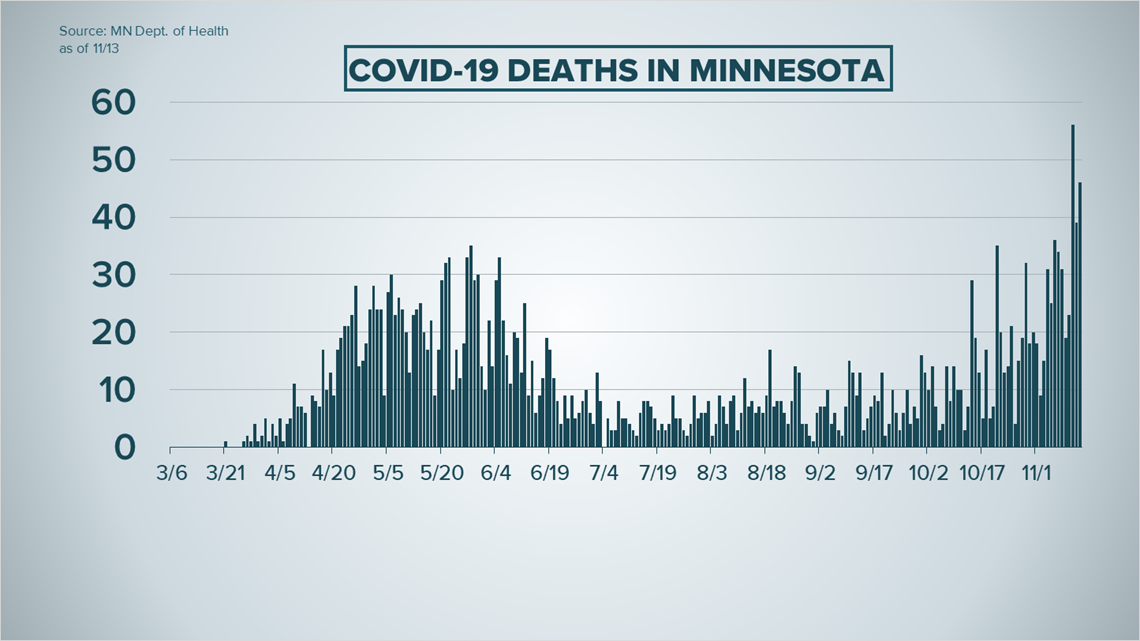
Total hospitalizations are now up to 12,644 since the start of the pandemic, with 3,119 of those patients requiring care in the ICU. MDH says in the past day, 1,424 beds were being used for COVID hospital patients at hospitals across the state, 293 of them ICU beds.
State health officials say 161,756 people who at one time tested positive for the virus have recovered enough that they no longer require isolation.
The group of Minnesotans ages 20 to 24 make up the state's largest number of coronavirus cases with 24,364. Two people in this age group have now died of the virus, with one being reported Friday. People from 25 to 29 account for 19,833 cases and three deaths, while those 30 to 34 number 17,928 and nine fatalities.
Seniors from 85 to 89 make up the largest grouping of coronavirus deaths, with 522 in just 2,656 cases. That means 20%, or one in five people from this age group who were diagnosed with the virus have died from it.
Hennepin County reports the most COVID activity with 47,534 cases and 1,035 deaths, followed by Ramsey County with 20,009 cases and 424 deaths. Dakota County reports 14,491 cases and 157 fatalities.
Cook County in northeastern Minnesota reports the least COVID activity with 39 cases and zero deaths, followed by Lake of the Woods County with 67 cases and one death.

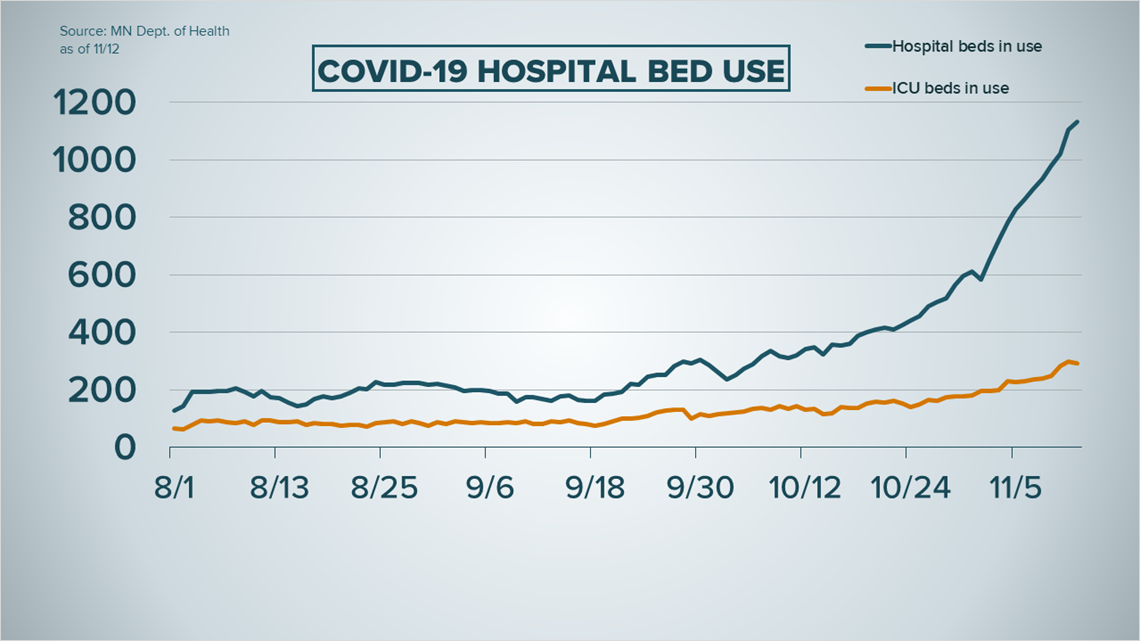
Thursday, Nov. 12
Noon
Newly released data from the Minnesota Department of Health (MDH) shows full distance learning is now recommended in 62 of Minnesota's 87 counties, and all of the state's counties now fall under minimum guidance of hybrid learning.
The new guidance is based on COVID-19 case rates per 10,000 people in each county between Oct. 18 and Oct. 31.
The full distance learning recommendation includes Anoka, Hennepin, Scott and Washington counties in the Twin Cities metro area, while Dakota and Ramsey counties are both within a point of falling under the same recommendations.
State officials have emphasized that this case data alone does not automatically determine the learning plan or any changes for a particular county or school district; the data is meant to be used as guidance in each district or school's decision-making process.
According to the state's Safe Learning Plan, the county case data leads to five recommended learning models:
- 0-9 cases per 10,000: In-person learning for all students
- 10-19 cases per 10,000: In-person learning for elementary students, hybrid learning for secondary students
- 20-29 cases per 10,000: Hybrid learning for all students
- 30-49 cases per 10,000: Hybrid learning for elementary students, distance learning for secondary students
- 50 or more cases per 10,000: Distance learning for all students
However, no counties currently fall into the two lowest recommended categories.
Minnesota officials also announced 11 new in-person testing sites, all opening this month. They're listed below. Additionally, the COVID-19 Test at Home program is now available to all Minnesotans across the state -- with or without insurance.
- Albert Lea National Guard Armory
410 Prospect Ave.
Opens Nov. 18 - Anoka National Guard Armory
408 Main Street E
Opens Nov. 17 - Crookston National Guard Armory
1801 University Ave.
Opens Nov. 16 - Fairmont National Guard Armory
700 N Fairlakes Ave.
Opens Nov. 18 - Hibbing National Guard Armory
2310 Brooklyn Dr.
Opens Nov. 18 - Hutchinson National Guard Armory
1200 Adams St. SE
Opens Nov. 30 - Inver Grove Heights
National Guard Armory
8076 Babcock Trail
Opens Nov. 17 - Morris National Guard Armory
722 Iowa Ave.
Opens Nov. 18 - Stillwater National Guard Armory
350 Maryknoll Dr. N.
Opens Nov. 16 - Wadena National Guard Armory
517 Jefferson St. N.
Opens Nov. 18
11 a.m.
The Minnesota Department of Health (MDH) reported a single-day record high of 7,228 COVID-19 cases Thursday.
The total case count in Minnesota since the start of the pandemic has now crossed the 200,000 mark with 201,795 cases.
There were 39 newly reported deaths Thursday, which brings the death count in the state to 2,793. Out of the 39 deaths, 23 were in long-term or assisted care facilities.

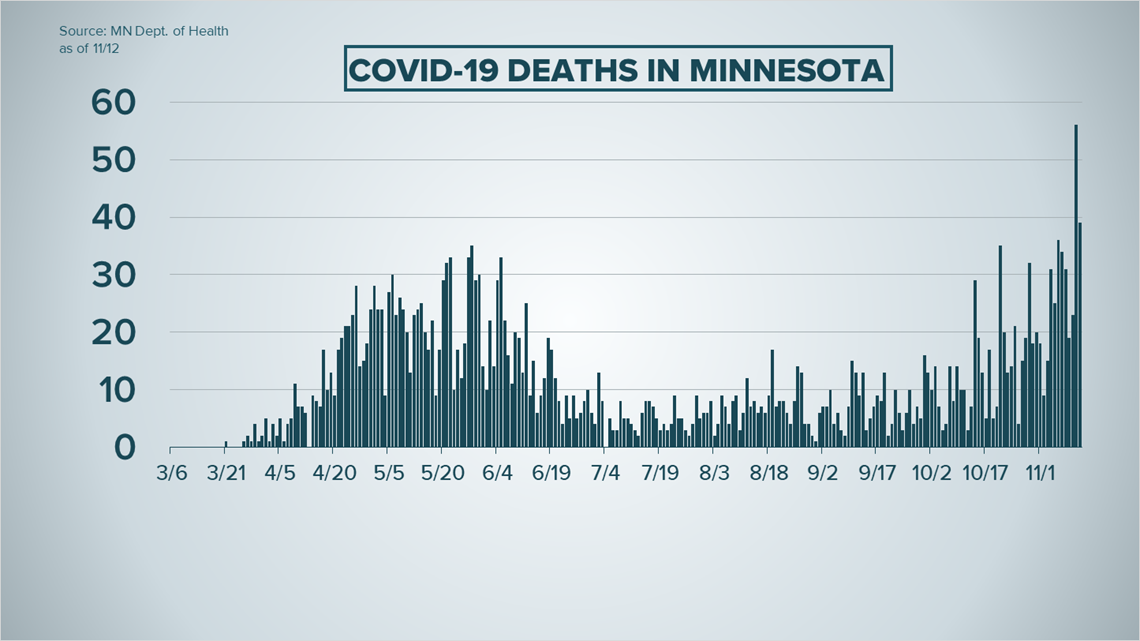
Of the cumulative case count, 159,467 Minnesotans no longer require isolation, according to MDH.
The 201,795 cases come from an approximate total of 3,253,880 tests completed by MDH and external laboratories.
A total of 12,443 have been hospitalized and 3,086 of the cases have been in the ICU at one point. There are currently 1,017 hospital beds in use for COVID and 282 ICU beds.
Young adults ages 20-24 have the largest share of infections with 23,824 cases and one death.
However, seniors ages 85-90 have the largest share of deaths with 511 deaths and 2,606 cases.
Hennepin County continues to report the most COVID activity with 46,555 cases and 1,033 deaths, followed by Ramsey County with 19,535 cases and 423 deaths. Anoka County reports 14,363 cases and 185 deaths.
KARE 11’s coverage of the coronavirus is rooted in Facts, not Fear. Visit kare11.com/coronavirus for comprehensive coverage, find out what you need to know about the Midwest specifically, learn more about the symptoms, and see what businesses are open as the state slowly lifts restrictions. Have a question? Text it to us at 763-797-7215. And get the latest coronavirus updates sent right to your inbox every morning. Subscribe to the KARE 11 Sunrise newsletter here. Help local families in need: www.kare11.com/give11.
The state of Minnesota has set up a data portal online at mn.gov/covid19.

